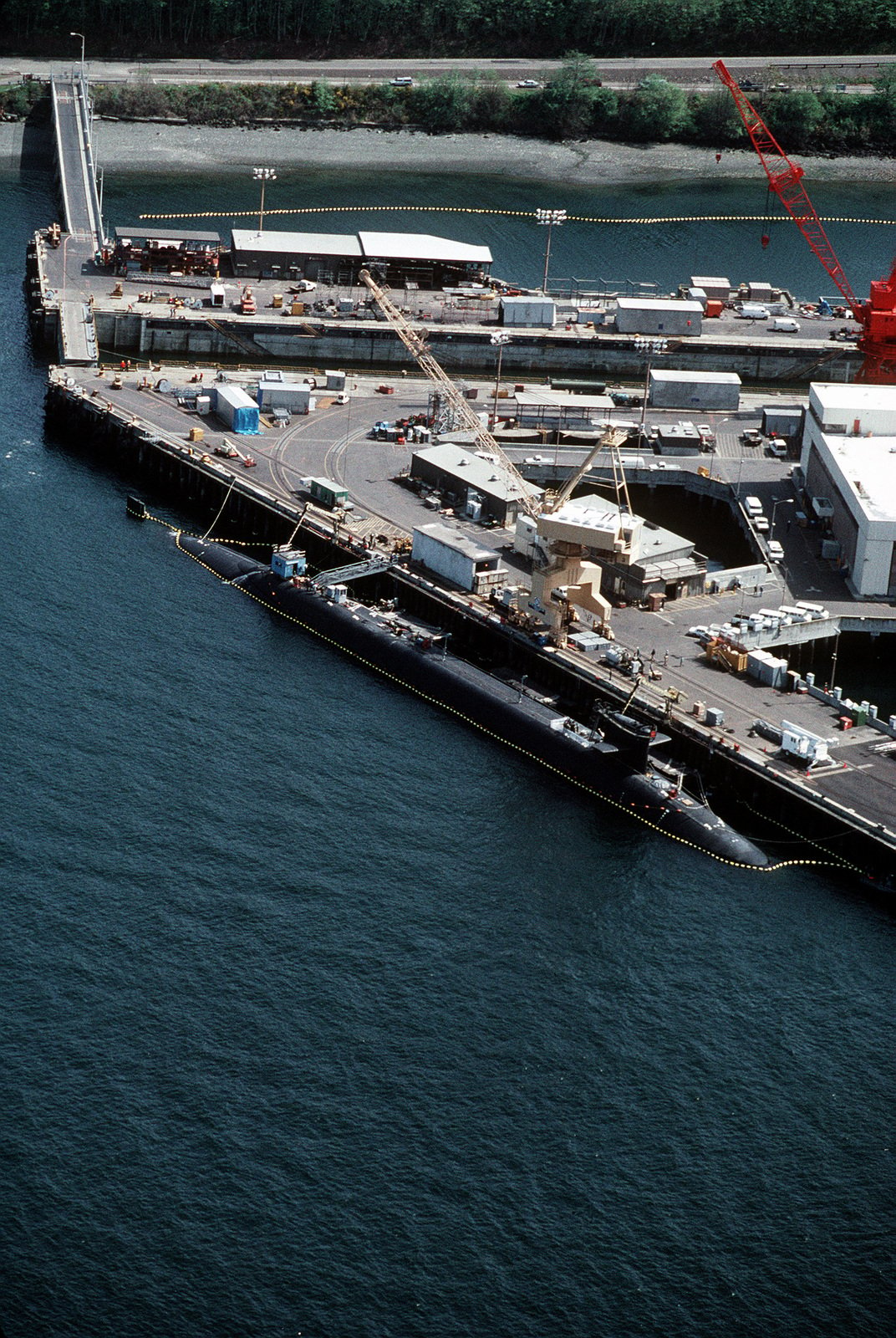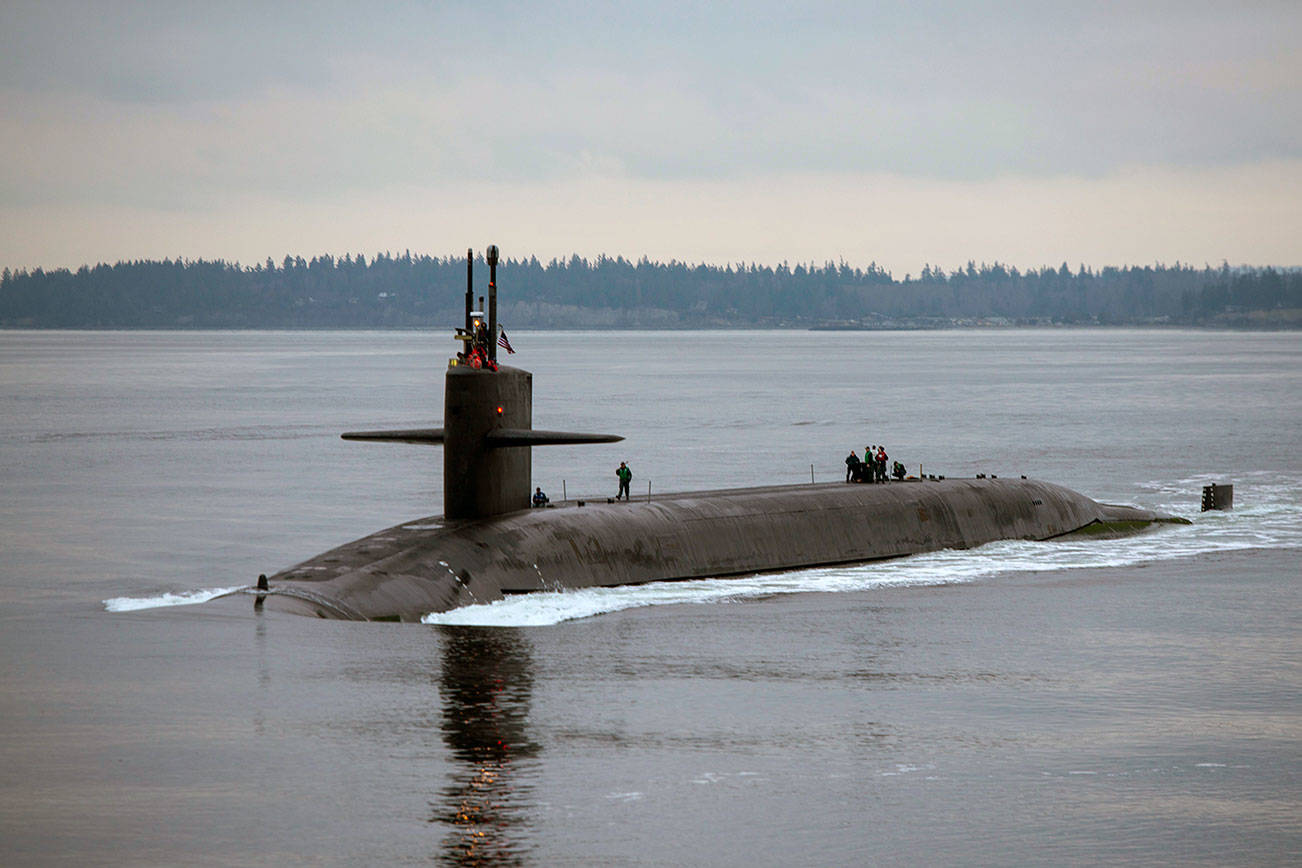Bangor Submarine Base Washington - 47°43′27.84″N 122°43′12.17″W / 47.7244000°N 122.7200472°W / 47.7244000; -122.7200472 Coordinates: 47°43′27.84″N 122°43′12.17″W / 47.7244000°N 122.7200472°W / 47.7244000; -122.7200472
Naval Submarine Base Bangor and the tug Mishawaka (back left) and three other Natick-class tugs guide the USS Ohio (SSGN-726) out of dry dock at Delta Pier
Bangor Submarine Base Washington

Naval Submarine Base Bangor was a former United States Navy submarine base that was merged with Naval Station Bremerton into Naval Base Kitsap in 2004.
Security Issue At Naval Base Kitsap Causes Lockdown
The naval history of Bangor Naval Support dates back to 1942 when it became an ammunition depot in the Pacific Theater of Operations during World War II. To expand and establish a permanent naval base, the United States Navy purchased 7,676 acres (3,100 ha) of land in Hood Canal near the city of Bangor, Washington for approximately $18.7 million. US Army Ammunition Magazine. laid down on 5 June 1944 for construction and commenced operations in January 1945.
From World War II, and the Korean War and the Vietnam War, until January 1973, the Bangor Annex continued its service as a US Navy Ammunition Depot responsible for export of conversion weapons to other countries.
In 1973, the Navy announced the selection of the Bangor base as the home port for the first group of Tridt Fleet Ohio-class ballistic missile submarines. The Tridt Foundation was officially opened on February 1, 1977. Naval Base Kitsap includes the Strategic Weapons Facility Pacific (SWFPAC) which provides storage, maintenance, missile assembly/testing, spare parts, and nuclear warhead storage for the UGM-133 Tridt II submarine-launched nuclear missiles.
This Tridt underwater base is the only one in the US. Pacific Fleet and Tridt Submarine Base in Kings Bay, Georgia, United States. Atlantic Fleet was one.
File:uss Maine Returns To Naval Base Kitsap
Marine Corps Security Forces Battalion Bangor has protected cruise missile submarines and related infrastructure since before being designated as an enterprise-sized special security unit in October 1978. The new command was named Naval Base Kitsap.
US Naval Submarine Base (SUBASE), Bangor is located on the eastern shore of Hood Canal. The foundation's dock facilities are located along two miles of waterfront. The original swimming facilities at SUBASE Bangor included four separate dock complexes: "KB" Docks, Delta Pier, Marginal Pier and Explosive's Handling Wharf. Trident submarines dock at Marginal Pier South and Delta Pier North and South. They also operate the explosives handling dock and the dry dock at Delta Dock. According to port authorities, submarines rarely have cabins, and when they do, they only stay for a day or two. Raised decks are 20 feet higher, meaning lower water levels. Lateral water depth varies from 45 feet at Marginal Wharves North and South, to 60 to 115 feet at Delta Piers.
The original swimming facilities at SUBASE Bangor included four separate dock complexes: "KB" Docks, Delta Pier, Marginal Pier and Explosive's Handling Wharf. Trident submarines dock at Marginal Pier South and Delta Pier North and South. They also operate the explosives handling dock and the dry dock at Delta Dock. According to port authorities, submarines rarely have cabins, and when they do, they only stay for a day or two. Raised decks are 20 feet higher, meaning lower water levels. Lateral water depth varies from 45 feet at Marginal Wharves North and South, to 60 to 115 feet at Delta Piers.

There are no fixtures available at SUBASE Bangor. Shipping buoys are available near the KB docks. SUBASE Bangor has a complement of 2,000hp YTB tugs and 1,600hp twin screw commercial tugs. Local authorities say pilots are used for all submarine arrivals at Bangor. Riders can be picked up at any point on the Dirty Science at the Hood Canal entrance south of Bangor, as requested. If the officer in charge of the submarine has passed the Hood Canal Bridge once, the pilot has his exit option. If towing assistance is required, the test is mandatory
Navy To Congress: Columbia Class Submarine Program Still On Schedule With Little Margin For Error
Winds from the southwest directly affect Bangor's wharf facilities due to the position of the Hood Canal. Winds are amplified as seen to the northeast across the channel by visualizing the channel relative to the adjacent topography. Operations at the explosives handling dock, Delta dry dock and magnetic silencer facility will cease if wind speeds reach 25 kt. Wind alone is not a problem for surface-mounted submarines, but it causes waves to overturn their ships.
The KB docks are operated by small arms from the Naval Undersea Equipment Engineering Station (NUWES) in Keyport. Bangor pilots say lines are doubled and dead lines and buoys are used to prevent excessive movement of moored vessels during periods of strong southwesterly winds. Most ships are moored inside the docks, but YTTs (Torpedo Recovery Boats - 135-140 feet long/1,600 tons) are moored outside the docks and exposed to any conditions in Hood Canal.
The only hazard identified at SUBASE Bangor is strong southwesterly winds across Hood Channel. Because of their low profile, the wind poses no direct danger to submarines. However, it can affect the ability of tugboats to operate alongside submarines. It may also affect the performance of small craft and YTTs from NUWES Keyport via the KB Dock complex. Whenever winds approach 50 kt, the Hood Canal Bridge is closed to vehicular traffic and kept open to reduce wind stress on the bridge structure. The floating bridge was partially destroyed by winds/waves on February 13, 1979 during a very strong wind storm.
Delta Southwest Pier and KB Piers experience four to six waves with strong winds (up to 60 kt). As long as the entrances to the submarines are closed, the waves are not a direct problem for the submarines. However, if towed alongside the submarine, the wave action can cause an up and down tow with possible damage to the submarine. To prevent such damage, normal towing operations are suspended in high wind conditions.
Incidental Take Authorization: Service Pier Extension Project On Naval Base Kitsap Bangor, Washington
Currents in Hood Canal, a partially enclosed basin, are driven largely by tides. Near SUBASE, northeasterly setting ebb currents in the range of 1.0 to 1.2 kt are common. Because of the steep slopes on both sides of the Hood Canal, heavy rains cause long runs. The extended ruff adds to the tidal flow during ebb, increasing the current speed to two kt. Local authorities say submarines that go offshore south of the Delta Pier during strong currents have difficulty moving upstream and away from the pier. Flood currents from the southwest are usually between 0.6 and 1 kt.
Navy plans called for POLARIS FBM submarines to operate in the Pacific. With this in mind, the DoD announced on 23 April 1962 the selection of several POLARIS support locations in the Pacific. The Puget Sound Naval Shipyard in Bremerton, Washington was chosen as the site for the FBM submarines; the Naval Weapons Facility in Bangor, Washington, was chosen as the site for the assembly of the POLARIS missiles; Pearl Harbor, Hawaii, was chosen as the training site for the crew. Construction of the $12.5 million facility at Bangor began in March 1963. On September 1, 1963, the missile assembly facility was established in a developmental state and the September 11, 1964 the POLARIS Missile Facility, Pacific (POMFPAC) was put into operation. the Naval Ordnance Depot, Bangor, Washington.
Bangor is located on the Kitsap Peninsula, on the banks of the Hood Canal. The base includes 7,676 hectares of land, 5,000 of which are wooded. Bangor is the natural home of a herd of deer, many bears and many other wildlife. The Olympic Mountains offer a beautiful view of the base.

POMFPAC flew its first mission to launch POLARIS A3 missiles from USS Stonewall Jackson (SSBN-634) on 26 March 1965, and the submarine departed on 9 April 1965 to begin patrol duties.
Safe And Sound At Seawolf
POMFPAC began converting PLARIS (A3) capabilities to the ANTELOPE (A3T) configuration in August 1970 and completed the Pacific ANTELOPE Exchange Program in February 1972.
The IDA 1967 STRAT-X report, in addition to proposing a new ULMS submarine and missiles, also proposed concepts for a ULMS retrofit complex. To test the feasibility of the concept, the SSPO Director of the CNM Office initiated, directed, and coordinated the study of the ULMS remodeling complex. The purpose of the study, which began in November 1970, was to determine the feasibility, size, complexity, land, labor, and equipment money required and to evaluate and recommend sites for the 'Atlantic and the Pacific.
The main objective of the ULMS Refit Complex was to improve the utility (surveillance availability) of the SSBNs. The utilization rate depends on the reconfiguration capability and corresponding design of the SSBN. The location of the maintenance facility and the range power of the missiles determine the percentage of missiles "ready" in the rapid reaction mode. New missiles for the extended range of the ULMS
Bangor submarine base wa, bangor washington navy base, bangor washington base housing, bangor submarine base, bangor naval base housing, washington state submarine base, washington submarine base, bangor washington naval base housing, naval submarine base bangor, sub base bangor washington, bangor naval base washington, bangor maine submarine base
0 Comments